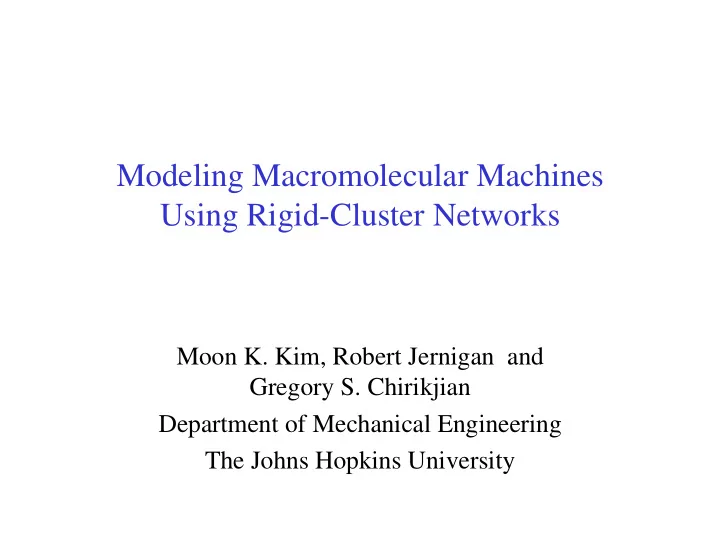

Modeling Macromolecular Machines Using Rigid-Cluster Networks Moon K. Kim, Robert Jernigan and Gregory S. Chirikjian Department of Mechanical Engineering The Johns Hopkins University
2 Coarse-grained elastic network model side chain R H C α OH N C H H O animo group carboxyl group peptide O R H H bond N C H C α C α OH N C H R H O DOF : 90% ↓ H 2 O • Only C α atoms in a protein are treated as point masses and spatially proximal points are assumed to be linked with linear springs.
3 Normal mode analysis (NMA) • NMA is a conventional harmonic analysis to calculate vibrational and thermal behaviors of macromolecules around a low energy equilibrium conformation. • However, it is not able to predict large anharmonic motions and pathways. • A simplified harmonic potential is derived from a coarse- grained elastic network model. • The generalized eigenvalue problem results in – Eigenvalues: the vibrational frequencies – Eigenvectors: the details of corresponding motions
4 NMA for GroEL-GroES complex Twisting (mode 1) Sliding (mode 2) Squeezing (mode 6)
5 Elastic network interpolation (ENI) • Large anharmonic motions and pathways can be generated by using the simplest cost function based on coarse- grained models. • The key idea is to interpolate two values of the distances between residues in both conformations. • Unrealistic conformations and steric clashes do not happen. • ENI pathway monotonically minimizes the root-mean- square-deviation (RMSD) between the two end conformations. • Realistic change of internal variables is observed during the transition along the ENI pathway.
6 ENI derivation • Cost function is • Desired distance is • The union liking matrix is used to force the initial conformation to move toward the final conformation.
7 • The simplified cost function is • The solution is obtained from • should be reduced to an invertible matrix. – Linear momentum conservation • Intermediate conformations are iteratively calculated. and • RMS superposition is needed for smooth animation of conformational transition.
Lactoferrin Transition from 1lfg.pdb to 1lfh.pdb
Lactate Dehydrogenase Transition from 1ldm.pdb to 6ldh.pdb
Citrate Synthase Transition from 4cts.pdb to 1cts.pdb
Conformational Transitions in Virus Capsid HK97 Primary ( 1FH6 to 1IF0)
12 ENI for GroEL-GroES complex • ENI represents an improvement over simplified linear interpolation in terms of the realism of intermediate conformations, and over all atom based MD and NMA, in terms of computational efficiency.
13 Rigid-cluster systems • Most conformational changes in macromolecules can be resolved into hinge and shear motions which are associated with the collective behavior of atoms. • Some macromolecules could be represented by a set of rigid-clusters. The center of mass of the i th cluster is • where x i (t) m i,a i th cluster d i,a (t)
14 Rigid-cluster ENI i th cluster • The position of residue a at time t is t 0 ∆ t t 1 v i (t 1 ) • Assuming small rigid-body displacement, x i (t 1 ) d i,a (0) where ω i (t 1 ) x i (0) d i,a (t 1 ) and translational orientational • The new ENI cost function is defined as
15 Lactoferrin 7 6 RMS[Angstrom] 5 4 Target Initial 3 2 1 0 0 20 40 60 80 100 Index of conformations Ratio of DOF = =
16 Virtual torsion angle 100 Thr90 Val250 50 Torsion Angle[Degree] 0 -50 -100 -150 0 20 40 60 80 100 Index of conformations • This monotonic angle changes indicate that the computed conformational transition seems to be naturally favorable and energetically feasible.
17 Conclusions (Part 2) • Coarse-grained elastic network models are addressed as a new tool for the study of biomolecular structure and dynamics. • Only C α atoms are treated as representatives of each residue of a protein and the interaction between proximal residues is modeled with a linear spring. • The ENI method is developed for the realistic simulation of conformational transition between the two different conformations in macromolecules. • This method is extended to rigid-cluster systems. The system modeling is much simplified when using rigid clusters instead of C α coarse graining. • The rigid-cluster ENI method is computationally faster than the conventional C α ENI, still observing steric constraints.
Recommend
More recommend